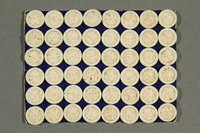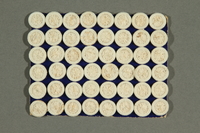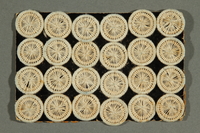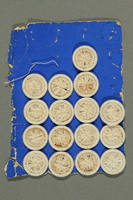Overview
- Description
- Contains a composition book bearing the name Hertha Schwarzbart and the dates 1921-22 handwritten on the cover.
- Date
-
1921-1922
- Credit Line
- United States Holocaust Memorial Museum Collection, Gift of Joyce Stoer Cordi
Physical Details
- Genre/Form
- School notebooks.
- Extent
-
1 folder
Rights & Restrictions
- Conditions on Access
- There are no known restrictions on access to this material.
- Conditions on Use
- Material(s) in this collection may be protected by copyright and/or related rights. You do not require further permission from the Museum to use this material. The user is solely responsible for making a determination as to if and how the material may be used.
Administrative Notes
- Holder of Originals
-
United States Holocaust Memorial Museum
- Legal Status
- Permanent Collection
- Provenance
- This collection was donated to the USHMM in 2018 by Joyce Cordi.
- Record last modified:
- 2024-03-08 07:33:43
- This page:
- https://collections.ushmm.org/search/catalog/irn612078
Download & Licensing
- In Copyright - Use Permitted
- Terms of Use
- This record is not digitized and cannot be downloaded online.
In-Person Research
- Request 7 Days in Advance of Visit
- Plan a Research Visit
-
Request in Shapell Center Reading Room
Bowie, MD
Contact Us
Also in Leopold and Herta Stoer family collection
The collection consists of opera glasses, buttons, textiles, petticoats, a Rorschach ink blot test, and a composition book, relating to the experiences of Leopold and Herta Schwartzbart Stoer and their family in Austria before the Holocaust and in Austria, Belgium, Poland, and the United States during the Holocaust.
Date: approximately 1898-1948

Opera glasses and case owned by a Jewish Austrian refugee
Object
Opera glasses with mother-of-pearl panels brought to the United States by Herta Schwarzbart Stoer when she emigrated from Vienna, Austria, in February 1939. Herta lived in Vienna with her parents, Arthur and Pauline Schwarzbart, and four siblings: Hilda, Fritz, Ella, and Hansi. In August 1914, Arthur was selected to fight in World War I, and three months later, he died of tetanus. As a result, Pauline had to close the lingerie business they ran together before the war. Her daughter, Hilda began making and selling children’s clothing. Pauline’s younger children, Fritz, Ella, Herta, and Hansi, were sent to an orphanage. Herta was transferred to a boarding school for Jewish orphan girls, where she later returned as a teacher. In 1932, Hansi married and moved to Palestine. In early 1936, Herta began dating Leopold (Leo) Stoer. In June 1937, Pauline passed away. On March 13, 1938, Austria was annexed into Germany. Later that month, Herta and Leo married, but continued to live separately in Vienna. Leo immigrated to the US in September 1938, followed by Herta in February 1939. In September, the couple moved to California, where they began running a chicken farm to raise money to help their families immigrate. As World War II progressed, Herta and Leo lost contact with most family members. Herta later learned that her family members had been deported to concentration camps and killed in 1942 or 1943. Only her sister-in-law, Sidi, and nephew, Paul Schwarzbart, survived in hiding. Leo’s entire family had been deported to concentration camps and killed in 1942.

Lace-trimmed Handkerchief with a cutwork floral accent owned by a Jewish Austrian refugee
Object
Lace-trimmed handkerchief brought to the United States by Herta Schwarzbart Stoer when she emigrated from Vienna, Austria, in February 1939. Herta lived in Vienna with her parents, Arthur and Pauline Schwarzbart, and four siblings: Hilda, Fritz, Ella, and Hansi. In August 1914, Arthur was selected to fight in World War I, and three months later, he died of tetanus. As a result, Pauline had to close the lingerie business they ran together before the war. Her daughter, Hilda began making and selling children’s clothing. Pauline’s younger children, Fritz, Ella, Herta, and Hansi, were sent to an orphanage. Herta was transferred to a boarding school for Jewish orphan girls, where she later returned as a teacher. In 1932, Hansi married and moved to Palestine. In early 1936, Herta began dating Leopold (Leo) Stoer. In June 1937, Pauline passed away. On March 13, 1938, Austria was annexed into Germany. Later that month, Herta and Leo married, but continued to live separately in Vienna. Leo immigrated to the US in September 1938, followed by Herta in February 1939. In September, the couple moved to California, where they began running a chicken farm to raise money to help their families immigrate. As World War II progressed, Herta and Leo lost contact with most family members. Herta later learned that her family members had been deported to concentration camps and killed in 1942 or 1943. Only her sister-in-law, Sidi, and nephew, Paul Schwarzbart, survived in hiding. Leo’s entire family had been deported to concentration camps and killed in 1942.

Card with 48 Dorset-style buttons owned by a Jewish Austrian refugee
Object
Unused set of handwoven buttons brought to the United States by Herta Schwarzbart Stoer when she emigrated from Vienna, Austria, in February 1939. The buttons were likely from one of Herta’s family member’s clothing businesses: either lingerie made by her parents, Arthur and Pauline, or children’s clothing made by her sister, Hilda. Herta lived in Vienna with her parents, and four siblings: Hilda, Fritz, Ella, and Hansi. In August 1914, Arthur was selected to fight in World War I, and three months later, he died of tetanus. As a result, Pauline closed the business, Hilda began making children’s clothing, and Fritz, Ella, Herta, and Hansi were sent to an orphanage. Herta was transferred to a boarding school for Jewish orphan girls, where she later returned as a teacher. In 1932, Hansi married and moved to Palestine. In early 1936, Herta began dating Leopold (Leo) Stoer. In June 1937, Pauline passed away. On March 13, 1938, Austria was annexed into Germany. Later that month, Herta and Leo married, but continued to live separately in Vienna. Leo immigrated to the US in September 1938, followed by Herta in February 1939. In September, the couple moved to California, where they began running a chicken farm to raise money to help their families immigrate. As World War II progressed, Herta and Leo lost contact with most family members. Herta later learned that her family members had been deported to concentration camps and killed in 1942 or 1943. Only her sister-in-law, Sidi, and nephew, Paul Schwarzbart, survived in hiding. Leo’s entire family had been deported to concentration camps and killed in 1942.

Card with 48 Dorset-style buttons owned by a Jewish Austrian refugee
Object
Unused set of handwoven buttons brought to the United States by Herta Schwarzbart Stoer when she emigrated from Vienna, Austria, in February 1939. The buttons were likely from one of Herta’s family member’s clothing businesses: either lingerie made by her parents, Arthur and Pauline, or children’s clothing made by her sister, Hilda. Herta lived in Vienna with her parents, and four siblings: Hilda, Fritz, Ella, and Hansi. In August 1914, Arthur was selected to fight in World War I, and three months later, he died of tetanus. As a result, Pauline closed the business, Hilda began making children’s clothing, and Fritz, Ella, Herta, and Hansi were sent to an orphanage. Herta was transferred to a boarding school for Jewish orphan girls, where she later returned as a teacher. In 1932, Hansi married and moved to Palestine. In early 1936, Herta began dating Leopold (Leo) Stoer. In June 1937, Pauline passed away. On March 13, 1938, Austria was annexed into Germany. Later that month, Herta and Leo married, but continued to live separately in Vienna. Leo immigrated to the US in September 1938, followed by Herta in February 1939. In September, the couple moved to California, where they began running a chicken farm to raise money to help their families immigrate. As World War II progressed, Herta and Leo lost contact with most family members. Herta later learned that her family members had been deported to concentration camps and killed in 1942 or 1943. Only her sister-in-law, Sidi, and nephew, Paul Schwarzbart, survived in hiding. Leo’s entire family had been deported to concentration camps and killn 1942.

Card with 24 Dorset-style buttons owned by a Jewish Austrian refugee
Object
Unused set of handwoven buttons brought to the United States by Herta Schwarzbart Stoer when she emigrated from Vienna, Austria, in February 1939. The buttons were likely from one of Herta’s family member’s clothing businesses: either lingerie made by her parents, Arthur and Pauline, or children’s clothing made by her sister, Hilda. Herta lived in Vienna with her parents, and four siblings: Hilda, Fritz, Ella, and Hansi. In August 1914, Arthur was selected to fight in World War I, and three months later, he died of tetanus. As a result, Pauline closed the business, Hilda began making children’s clothing, and Fritz, Ella, Herta, and Hansi were sent to an orphanage. Herta was transferred to a boarding school for Jewish orphan girls, where she later returned as a teacher. In 1932, Hansi married and moved to Palestine. In early 1936, Herta began dating Leopold (Leo) Stoer. In June 1937, Pauline passed away. On March 13, 1938, Austria was annexed into Germany. Later that month, Herta and Leo married, but continued to live separately in Vienna. Leo immigrated to the US in September 1938, followed by Herta in February 1939. In September, the couple moved to California, where they began running a chicken farm to raise money to help their families immigrate. As World War II progressed, Herta and Leo lost contact with most family members. Herta later learned that her family members had been deported to concentration camps and killed in 1942 or 1943. Only her sister-in-law, Sidi, and nephew, Paul Schwarzbart, survived in hiding. Leo’s entire family had been deported to concentration camps and killed in 1942.

Partial card with 16 Dorset-style buttons owned by a Jewish Austrian refugee
Object
Partial set of handwoven buttons brought to the United States by Herta Schwarzbart Stoer when she emigrated from Vienna, Austria, in February 1939. The buttons were likely from one of Herta’s family member’s clothing businesses: either lingerie made by her parents, Arthur and Pauline, or children’s clothing made by her sister, Hilda. Herta lived in Vienna with her parents, and four siblings: Hilda, Fritz, Ella, and Hansi. In August 1914, Arthur was selected to fight in World War I, and three months later, he died of tetanus. As a result, Pauline closed the business, Hilda began making children’s clothing, and Fritz, Ella, Herta, and Hansi were sent to an orphanage. Herta was transferred to a boarding school for Jewish orphan girls, where she later returned as a teacher. In 1932, Hansi married and moved to Palestine. In early 1936, Herta began dating Leopold (Leo) Stoer. In June 1937, Pauline passed away. On March 13, 1938, Austria was annexed into Germany. Later that month, Herta and Leo married, but continued to live separately in Vienna. Leo immigrated to the US in September 1938, followed by Herta in February 1939. In September, the couple moved to California, where they began running a chicken farm to raise money to help their families immigrate. As World War II progressed, Herta and Leo lost contact with most family members. Herta later learned that her family members had been deported to concentration camps and killed in 1942 or 1943. Only her sister-in-law, Sidi, and nephew, Paul Schwarzbart, survived in hiding. Leo’s entire family had been deported to concentration camps and killed in 1942.

Card with 46 Dorset-style buttons owned by a Jewish Austrian refugee
Object
Partial set of handwoven buttons brought to the United States by Herta Schwarzbart Stoer when she emigrated from Vienna, Austria, in February 1939. The buttons were likely from one of Herta’s family member’s clothing businesses: either lingerie made by her parents, Arthur and Pauline, or children’s clothing made by her sister, Hilda. Herta lived in Vienna with her parents, and four siblings: Hilda, Fritz, Ella, and Hansi. In August 1914, Arthur was selected to fight in World War I, and three months later, he died of tetanus. As a result, Pauline closed the business, Hilda began making children’s clothing, and Fritz, Ella, Herta, and Hansi were sent to an orphanage. Herta was transferred to a boarding school for Jewish orphan girls, where she later returned as a teacher. In 1932, Hansi married and moved to Palestine. In early 1936, Herta began dating Leopold (Leo) Stoer. In June 1937, Pauline passed away. On March 13, 1938, Austria was annexed into Germany. Later that month, Herta and Leo married, but continued to live separately in Vienna. Leo immigrated to the US in September 1938, followed by Herta in February 1939. In September, the couple moved to California, where they began running a chicken farm to raise money to help their families immigrate. As World War II progressed, Herta and Leo lost contact with most family members. Herta later learned that her family members had been deported to concentration camps and killed in 1942 or 1943. Only her sister-in-law, Sidi, and nephew, Paul Schwarzbart, survived in hiding. Leo’s entire family had been deported to concentration camps and killed in 1942.
Cream-colored underskirt with a diamond pattern owned by a Jewish Austrian refugee
Object
Diamond-patterned petticoat brought to the United States by Herta Schwarzbart Stoer when she emigrated from Vienna, Austria, in February 1939. The underskirt was created in the early 1900s by her parents, Arthur and Pauline, who ran their own lingerie manufacturing business. Herta lived in Vienna with her parents, and four siblings: Hilda, Fritz, Ella, and Hansi. In August 1914, Arthur was selected to fight in World War I, and three months later, he died of tetanus. As a result, Pauline closed the business, and sent Fritz, Ella, Herta, and Hansi to an orphanage. Hilda and Pauline ran a small children’s clothing business. Herta was transferred to a boarding school for Jewish orphan girls, where she later returned as a teacher. In 1932, Hansi married and moved to Palestine. In early 1936, Herta began dating Leopold (Leo) Stoer. In June 1937, Pauline passed away. On March 13, 1938, Austria was annexed into Germany. Later that month, Herta and Leo married, but continued to live separately in Vienna. Leo immigrated to the US in September 1938, followed by Herta in February 1939. In September, the couple moved to California, where they began running a chicken farm to raise money to help their families immigrate. As World War II progressed, Herta and Leo lost contact with most family members. Herta later learned that her family members had been deported to concentration camps and killed in 1942 or 1943. Only her sister-in-law, Sidi, and nephew, Paul Schwarzbart, survived in hiding. Leo’s entire family had been deported to concentration camps and killed in 1942.
Initialed, cream-colored underskirt with a diamond pattern owned by a Jewish Austrian refugee
Object
Monogrammed petticoat brought to the United States by Herta Schwarzbart Stoer when she emigrated from Vienna, Austria, in February 1939. The underskirt was likely part of her mother Pauline’s (née Flesch) trousseau, created prior to her marriage to Arthur Schwarzbart in 1900. Herta lived in Vienna with her parents, who ran their own lingerie manufacturing business, and four siblings: Hilda, Fritz, Ella, and Hansi. In August 1914, Arthur was selected to fight in World War I, and three months later, he died of tetanus. As a result, Pauline closed the business, and sent Fritz, Ella, Herta, and Hansi to an orphanage. Hilda and Pauline ran a small children’s clothing business. Herta was transferred to a boarding school for Jewish orphan girls, where she later returned as a teacher. In 1932, Hansi married and moved to Palestine. In early 1936, Herta began dating Leopold (Leo) Stoer. In June 1937, Pauline passed away. On March 13, 1938, Austria was annexed into Germany. Later that month, Herta and Leo married, but continued to live separately in Vienna. Leo immigrated to the US in September 1938, followed by Herta in February 1939. In September, the couple moved to California, where they began running a chicken farm to raise money to help their families immigrate. As World War II progressed, Herta and Leo lost contact with most family members. Herta later learned that her family members had been deported to concentration camps and killed in 1942 or 1943. Only her sister-in-law, Sidi, and nephew, Paul Schwarzbart, survived in hiding. Leo’s entire family had been deported to concentration camps and killed in 1942.
Cream-colored, underskirt with a diamond pattern and an eyelet ruffle owned by a Jewish Austrian refugee
Object
Petticoat with an eyelet ruffle brought to the United States by Herta Schwarzbart Stoer when she emigrated from Vienna, Austria, in February 1939. The underskirt was created in the early 1900s by her parents, Arthur and Pauline, who ran their own lingerie manufacturing business. Herta lived in Vienna with her parents, and four siblings: Hilda, Fritz, Ella, and Hansi. In August 1914, Arthur was selected to fight in World War I, and three months later, he died of tetanus. As a result, Pauline closed the business, and sent Fritz, Ella, Herta, and Hansi to an orphanage. Hilda and Pauline ran a small children’s clothing business. Herta was transferred to a boarding school for Jewish orphan girls, where she later returned as a teacher. In 1932, Hansi married and moved to Palestine. In early 1936, Herta began dating Leopold (Leo) Stoer. In June 1937, Pauline passed away. On March 13, 1938, Austria was annexed into Germany. Later that month, Herta and Leo married, but continued to live separately in Vienna. Leo immigrated to the US in September 1938, followed by Herta in February 1939. In September, the couple moved to California, where they began running a chicken farm to raise money to help their families immigrate. As World War II progressed, Herta and Leo lost contact with most family members. Herta later learned that her family members had been deported to concentration camps and killed in 1942 or 1943. Only her sister-in-law, Sidi, and nephew, Paul Schwarzbart, survived in hiding. Leo’s entire family had been deported to concentration camps and killed in 1942.
Short, white eyelet lace jacket owned by a Jewish Austrian refugee
Object
Short, eyelet-lace jacket brought to the United States by Herta Schwarzbart Stoer when she emigrated from Vienna, Austria, in February 1939. Herta lived in Vienna with her parents, Arthur and Pauline Schwarzbart, and four siblings: Hilda, Fritz, Ella, and Hansi. In August 1914, Arthur was selected to fight in World War I, and three months later, he died of tetanus. As a result, Pauline had to close the lingerie business they ran together before the war. Her daughter, Hilda began making and selling children’s clothing. Pauline’s younger children, Fritz, Ella, Herta, and Hansi, were sent to an orphanage. Herta was transferred to a boarding school for Jewish orphan girls, where she later returned as a teacher. In 1932, Hansi married and moved to Palestine. In early 1936, Herta began dating Leopold (Leo) Stoer. In June 1937, Pauline passed away. On March 13, 1938, Austria was annexed into Germany. Later that month, Herta and Leo married, but continued to live separately in Vienna. Leo immigrated to the US in September 1938, followed by Herta in February 1939. In September, the couple moved to California, where they began running a chicken farm to raise money to help their families immigrate. As World War II progressed, Herta and Leo lost contact with most family members. Herta later learned that her family members had been deported to concentration camps and killed in 1942 or 1943. Only her sister-in-law, Sidi, and nephew Paul Schwarzbart, survived in hiding. Leo’s entire family had been deported to concentration camps and killed in 1942.
Cream-colored textile with crocheted lace accents owned by a Jewish Austrian refugee
Object
Long textile with crocheted accents brought to the United States by Herta Schwarzbart Stoer when she emigrated from Vienna, Austria, in February 1939. Herta lived in Vienna with her parents, Arthur and Pauline Schwarzbart, and four siblings: Hilda, Fritz, Ella, and Hansi. In August 1914, Arthur was selected to fight in World War I, and three months later, he died of tetanus. As a result, Pauline had to close the lingerie business they ran together before the war. Her daughter, Hilda began making and selling children’s clothing. Pauline’s younger children, Fritz, Ella, Herta, and Hansi, were sent to an orphanage. Herta was transferred to a boarding school for Jewish orphan girls, where she later returned as a teacher. In 1932, Hansi married and moved to Palestine. In early 1936, Herta began dating Leopold (Leo) Stoer. In June 1937, Pauline passed away. On March 13, 1938, Austria was annexed into Germany. Later that month, Herta and Leo married, but continued to live separately in Vienna. Leo immigrated to the US in September 1938, followed by Herta in February 1939. In September, the couple moved to California, where they began running a chicken farm to raise money to help their families immigrate. As World War II progressed, Herta and Leo lost contact with most family members. Herta later learned that her family members had been deported to concentration camps and killed in 1942 or 1943. Only her sister-in-law, Sidi, and nephew, Paul Schwarzbart, survived in hiding. Leo’s entire family had been deported to concentration camps and killed in 1942.
Set of 10 Rorschach plates with folded cardboard enclosure owned by a Jewish Austrian refugee
Object
Rorschach ink blot test cards like those used by Dr. Leopold (Leo) Stoer to test patients in the United States following his emigration from Vienna, Austria, in September 1938. While studying for his dissertation in psychology, Leo learned how to use the cards to diagnose patients, which was still a new practice in the US. Leo lived in Vienna with his parents, Alfred and Karoline, and seven younger siblings: Juli, Grete, Hedi, Fritz, Erna, Trude, and Otto. In 1915, Alfred, a master decorator by trade, was selected to fight in World War I (1914-1918). Leo’s sister Hedi, died from whooping cough. After Leo graduated from school, he worked at an insurance company and took some university courses. He passed the university entrance exams in 1928, and began his PhD program the following year. In early 1936, Leo began dating Herta Schwarzbart. In November 1937, Leo was promoted after passing qualifying exams. On March 13, 1938, Austria was annexed into Germany. Later that month, Leo and Herta married, but continued to live separately in Vienna. Leo immigrated to the US in September 1938, after helping his family flee to Belgium. Herta followed him in February 1939. In September, the couple moved to California, where they began running a chicken farm to raise money to help their families immigrate. As World War II progressed, Herta and Leo lost contact with most family members. Leo later learned that his entire family had been deported to concentration camps and killed in 1942. All but two of Herta’s family members had been deported to concentration camps and killed by 1943.



